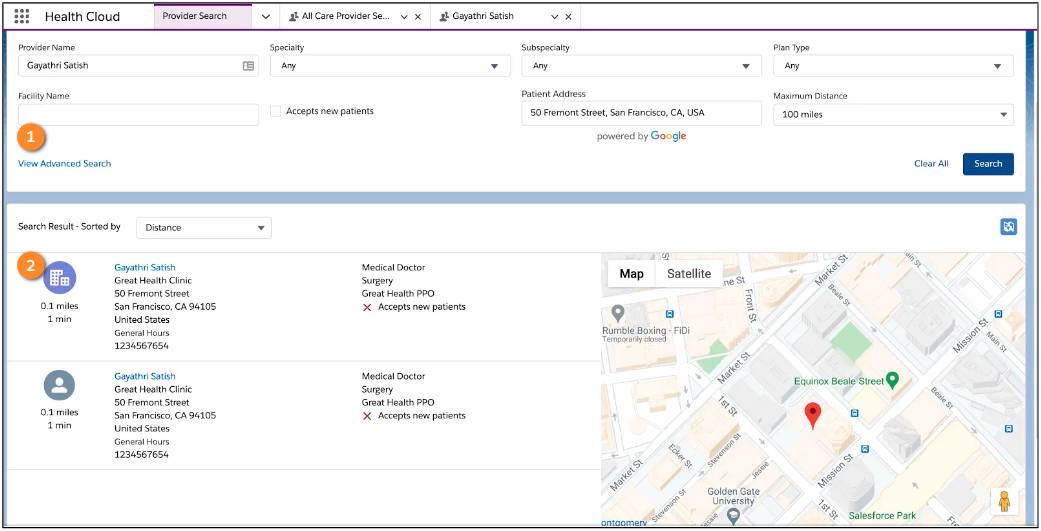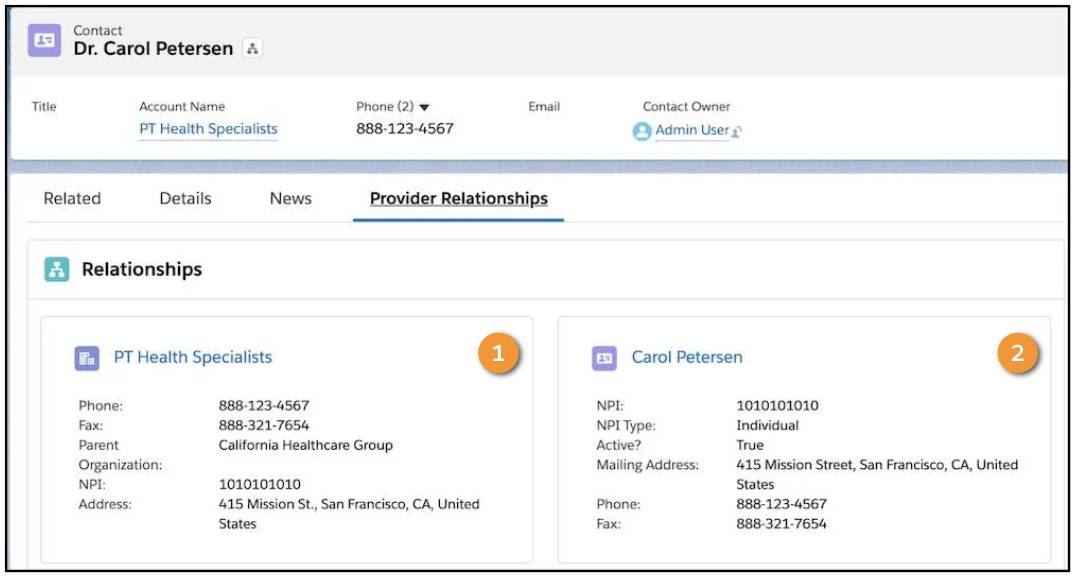Get Started with Provider Search and Cards
Learning Objectives
After completing this unit, you’ll be able to:
- Describe the purpose and the benefits of the provider search feature.
- Explain what Provider Relationship Cards are and how they benefit healthcare organizations.
Beyond Customer Engagement
This is Milly Lee. Milly and her husband Charles live a quiet life in the suburbs in Northern California. They are both close to retirement.

Milly and Charles love to hike on weekends. But lately, Milly has experienced hip pain when she walks through hilly terrains.

Her primary care physician recommends that she visits an orthopedic surgeon to get her hip checked. Milly is a member of Cumulus Health Plan, an insurance company, and calls Cumulus to get assistance with looking for an orthopedic surgeon.
Milly reaches Audrey, a contact center agent at Cumulus. All Cumulus contact center agents, including Audrey, use Salesforce to manage member relationships and complete everyday tasks. Audrey asks Milly a series of questions that help her find a suitable orthopedic surgeon for her. For example, she asks for Milly’s preferred location and preferred specialty. Using this information, she finds several doctors that meet Milly’s criteria and accept new patients. The one that suits Milly the best is Dr. Bass.
Audrey opens Dr. Bass’s record page straight from the search result. She navigates to a Provider Relationship tab on her record page. She notices cards with information about clinics that Dr. Bass is affiliated with and the days of the week she works there.
Audrey feels good about the search and proceeds to book an appointment for Milly with Dr. Bass. She also reminds Milly that she can use the patient portal to look up providers herself if that’s more convenient for her in the future.
How was Audrey able to find a suitable provider for Milly and see facilities where Dr. Bass works so seamlessly? The answer is the Provider Search and Provider Card features.
Meet Provider Search
Provider Search is a feature that helps users find healthcare providers based on criteria such as location, specialty, and if the provider is accepting new patients.
Call center agents and care coordinators typically use Provider Search. They access the feature directly from their Salesforce org, either from their home page, or an account or contact record page, depending on their setup. To search for providers, they enter any of the preferred search specifications and click Search. The specifications they can filter providers with include:
- Provider name
- Specialty and subspecialty
- Plan type
- Facility name
- Patient address and maximum distance the patient is willing to travel
They can also click the Accepts new patients checkbox so that the search returns only those providers who accept new patients.
Below is an example of what Provider Search looks like.

You can see the fields such as Provider Name, Specialty and Subspecialty on the top of the page (1). Below the search fields are the search results (2). This search is based on the provider name, Gayatri Satish, and the patient’s address in San Francisco. It returns two results for Gayatri Satish.
In the search results, you can see the name of the provider, Gayatri Satish, her address, general hours Gayatri works, what type of provider Gayatri is, and whether or not she accepts new patients. You can also see the driving distance of the place Gayatri works from the patient address and the travel time. This helps clients to plan their trips to the provider.
Call center agents and other staff members use the Provider Search feature directly in their org. However, you can embed Provider Search in community portals powered by Experience Cloud so that patients and members can also search for providers on their own using the same criteria, without having to call their insurance company. Finding the right provider for the patient couldn’t get any easier.
Get a Bird’s-Eye View with Provider Relationship Cards
Provider Cards quickly and efficiently show users like Audrey, the contact center agent at Cumulus, what they need to know about providers and the facilities where they work. They are like business cards, but what’s special about them is that they display whatever information you want them to display. You can store this information in many different objects, and Provider Cards bring this information together, in one place.
Provider Cards might include information such as:
- Practitioner’s contact information
- Practitioner’s location and opening hours
- Business information related to licenses, education, certification levels, and medical specialties that the practitioner is certified in
- Accounts the practitioner has a relationship with (for example employer, hospital affiliations, practice locations or billing company)
- Details of the practitioner’s relationship to those accounts
Users like contact center agents or care coordinators see Provider Cards in their org. They can be on either an account page or contact page of the provider or healthcare facility.
Here is an example of what a provider card looks like.

This is a contact record page for Dr. Carol Petersen. Notice two provider cards on the Provider Relationships tab. One card shows the provider facility that Dr. Carol Petersen is associated with - the PT Health Specialists facility (1). The card displays information about the facility, such as its phone and fax numbers, address, and its National Provider Identifier (NPI) number. The other card shows Dr. Carol Petersen’s information, such as her NPI number, mailing address and contact information (2).
Later in this module, you complete a hands-on challenge to practice using Provider Search. Make sure to get the special Developer Edition org that contains sample data now so that it’s ready when you need it.
Sign Up for a Developer Edition Org
To complete this module, you need a special Developer Edition org that contains sample data. Get the free Developer Edition and connect it to Trailhead now so you can complete the challenges in this module.
Even if you’ve recently signed up for a special Developer Edition org, sign up for a new one now. We’re always adding new data. Note that this Developer Edition is designed to work with the challenges in this badge, and may not work for other badges. Always check that you’re using the Trailhead Playground or special Developer Edition org that we recommend.
- Sign up for a free Developer Edition org.
- Fill out the form.
- For Email, enter an active email address.
- For Username, enter a username that looks like an email address and is unique. It doesn’t need to be a valid email account (for example, yourname@hc4evah.com is fine).
- After you fill out the form, click Sign me up. A confirmation message appears.
- When you receive the activation email (this might take a few minutes), open it and click Verify Account.
- Complete your registration by setting your password and challenge question.
Tip: Write down your username, password, and login URL for easy access later.
You are logged into your Developer Edition. Now connect your new Developer Edition org to Trailhead.
- Make sure you’re logged in to your Trailhead account.
- In the Challenge section at the bottom of this page, select Connect Org from the picklist.
- On the Login screen, enter the username and password for the Developer Edition org you just set up.
- On the Allow Access? screen, click Allow.
- On the Want to connect this org for hands-on challenges? screen, click Yes! Save it.
You’re returned to the challenge page, ready to use your new Developer Edition org to earn this badge.
Now that you've seen how call center agents and care coordinators typically use provider search and provider relationship cards, head to the next unit to explore how to configure them.
Resources
